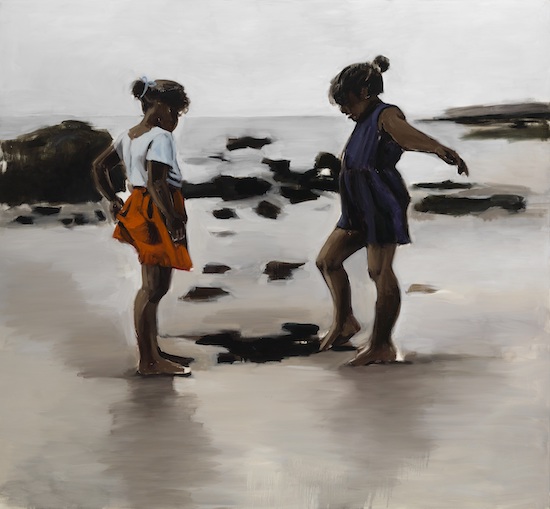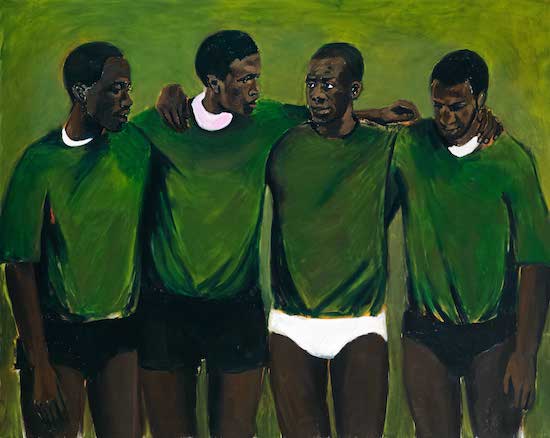Lynette Yiadom-Boakye, Tie the Temptress to the Trojan 2018. Collection of Michael Bertrand, Toronto © Courtesy of Lynette Yiadom-Boakye
The titles of Lynette Yiadom-Boakye’s paintings, which she describes as being like “an extra brushmark”, are beguiling, lyrical, and enigmatic. They add to the sense of narrative drama. The Cream and the Taste, reads one. This 2013 painting is a head and shoulders portrait of a woman, in her middle years, in semi-profile. With her quietly contemplative smile and what one might describe as a dreamy gaze, one reaches for the idiom of ‘the cat that got the cream’, or perhaps the title just forces us to remake the image. In any case, the mystery of the title remains.
Another is Hard Wet Epic, 2010, which belongs to a work painted on a more monumental, epic, scale, depicting three young men in shorts or swimming trunks strolling with easy purpose on a beach. Perhaps they’ve just emerged from the sea, though the background is sketchy, as it is in most of her paintings. Despite the porno title, there is little that is erotic or hyper-masculine about the three figures. They are not self-consciously posed but appear completely relaxed. It could have been painted from a casual snapshot.
Yiadom-Boakye paints solitary figures, figures in groups, figures in double portraits, as well as single figures as part of a diptych. Though she very rarely portrays mixed sex or gender groupings, that clearly doesn’t mean there aren’t intimations of the erotic at play. Tie the Temptress to the Trojan, 2016, for instance, shows a topless male figure lounging on a bed or couch, propped up on one elbow and firmly holding our gaze. His three-quarter length figure almost abuts the picture plane: we are being invited into this dark, intimate space. The checkered blue and red harlequin surface on which he lies enlivens the monotones of his lithe figure and the background.
In The Generosity (2010), two crouched male figures in matching white boxers, one elliptically meeting our gaze while pulling up a sock, the other oblivious to our presence while looking down to reach for his sock on the ground, might suggest a number of scenarios, including a sexual one. It’s the way the viewer appears to intrude onto the scene that creates the dramatic tension, while a pictorial tension is created partly by the way the white accents of the one visible eye belonging to the figure looking directly, almost furtively at us, is held in a taut rhythm with his white socks and underwear.
Yiadom-Boakye’s use of paint is incredibly seductive – loose and fluid and layered and sketchy, with accents of blazing colour coming through the layers of monotone, or searing passages of colour enlivening the flat abstractions of background.

Lynette Yiadom-Boakye, Condor and the Mole 2011. Arts Council Collection, Southbank Centre, London © Courtesy of Lynette Yiadom-Boakye
Though much has been made of the artist’s use of the conventions of portraiture for purely imagined characters occupying their fictive worlds, less has been made of the powerful presence of the past in Yiadom-Boakye’s contemporary set-ups. She directly references artists from Goya and Velázquez and Manet (especially in the latter’s Spanish period) to Sargent and Degas and Sickert. From gesture and pose to colour tone and painterly technique these artists in particular are as present in her paintings as the characters portrayed within them.
The Spanish influence is especially evident in two paintings which are hung as complements side by side in the exhibition: Wrist Action (2010), and the powerfully arresting Bound Over To Keep The Faith (2012). As companion pieces these are among two of the most seductive and striking paintings in Tate Britain’s mid-career retrospective of the artist, which goes by the title Fly In League With the Night.
These two paintings depict single male figures sitting in side view, their backs to each other in their respective frames. They each wear a whıte tunıc and a dazzling grin, their dark heads, turned to meet our gaze, emerging from a crepuscular gloom. In a surreal touch, the figure in Wrist Action, who appears to be the same character as that depicted in the companion piece, wears a pink glove on one prominently placed hand, while in Bound Over To Keep The Faith, his hand rests on his chin as he returns our stare in a pose that strongly echoes the provocative female nude in Manet’s Le Déjeuner sur l’herbe. Despite their confident and relaxed swagger there is something faintly sinister in their grins and stares frozen in perpetuity.

Lynette Yiadom-Boakye, Complication 2013. Private Collection © Courtesy of Lynette Yiadom-Boakye
The exhibition is hung non-chronologically, with paintings instead placed in conversation, rhyming in gesture, pose or composition. An early painting from 2003, called First, is heavy with echoes of Goya in grotesque mode. Here the squat male figure wears his house robe open to reveal his paunch and thick set frame. With his crude and exaggerated features there is something of the lewd Gothic villain about him. Placed in conversation with it, is a later, far more naturalistic painting: the seated figure of a young male draped in a red robe, his satiny white slippers offering another point of focus. He suggests the dazzling and seductive figure of John Singer Sargent’s Dr Pozzi.
The catalogue to the exhibition quotes the American writer and critic Hilton Als on Yiadom-Boakye’s necessarily radical act of centring her black figures in their self-contained worlds, noting that she is "interested in black society, not as it was affected or shaped by the white world, but as it exist[s] unto itself". She places the black figure as a disruptive force within a grand, and of course white, art historical tradition, but doesn’t let that tradition overwhelm or burden her. The sheer bravura force of her painting resists being undone by those she deftly quotes or pays homage to.
Lynette Yiadom-Boakye: Fly In League With The Night is at Tate Britain until 9 May 2021


